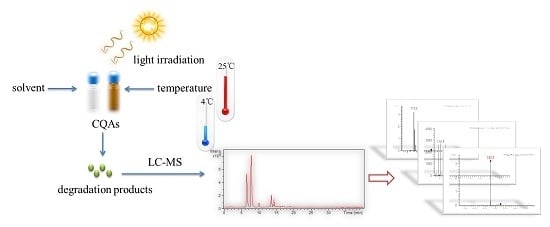Stability and Degradation of Caffeoylquinic Acids under Different Storage Conditions Studied by High-Performance Liquid Chromatography with Photo Diode Array Detection and High-Performance Liquid Chromatography with Electrospray Ionization Collision-Induced Dissociation Tandem Mass Spectrometry
Abstract
:1. Introduction
2. Results and Discussion
2.1. Method Validation
2.2. Thermal-Stability, Photo-Stability, and Solvent-Stability Study
2.2.1. Thermal-Stability Study
2.2.2. Photo-Stability Study
2.2.3. Solvent-Stability Study
2.3. Degradation Products Analysis
2.3.1. Degradation Products of Mono-Acyl CQAs
2.3.2. Degradation Products of Di-Acyl CQAs
3. Experimental Section
3.1. Chemicals and Materials
3.2. Preparation of Samples and Mixed Standard Solutions
3.3. HPLC Conditions
3.4. HPLC-DAD-ESI-MS/MS Analysis
4. Conclusions
Acknowledgments
Author Contributions
Conflicts of Interest
Abbreviations
| CGAs | Chlorogenic Acids |
| CQAs | Caffeoylquinic Acids |
| p-CoQAs | p-Coumaroylquinic Acids |
| FQAs | Feruloyl Quinic Acids |
| HPLC-PDA | High-Performance Liquid Chromatography with Photo Diode Array Detection |
| HPLC-MS/MS | High-Performance Liquid Chromatography Tandem Mass Spectroscopy |
| ESI-MS/MS | Electrospray Ionization Tandem Mass |
| S/N | Signal-to-Noise |
References
- Clifford, M.N.; Wu, W.; Kuhnert, N. The chlorogenic acids of Hemerocallis. Food Chem. 2006, 95, 574–578. [Google Scholar] [CrossRef]
- Clifford, M.N. Chlorogenic acids and other cinnamates—Nature, occurrence and dietary burden1. J. Sci. Food Agric. 1999, 79, 362–372. [Google Scholar] [CrossRef]
- Clifford, M.N. Chlorogenic acids and other cinnamates—Nature, occurrence, dietary burden, absorption and metabolism. J. Sci. Food Agric. 2000, 80, 1033–1043. [Google Scholar] [CrossRef]
- Jaiswal, R.; Deshpande, S.; Kuhnert, N. Profiling the chlorogenic acids of Rudbeckia hirta, Helianthus tuberosus, Carlina acaulis and Symphyotrichum novae-angliae leaves by LC-MSn. Phytochem. Anal. 2011, 22, 432–441. [Google Scholar] [CrossRef] [PubMed]
- Marques, V.; Farah, A. Chlorogenic acids and related compounds in medicinal plants and infusions. Food Chem. 2009, 113, 1370–1376. [Google Scholar] [CrossRef]
- Cropley, V.; Croft, R.; Silber, B.; Neale, C.; Scholey, A.; Stough, C.; Schmitt, J. Does coffee enriched with chlorogenic acids improve mood and cognition after acute administration in healthy elderly? A pilot study. Psychopharmacology 2012, 219, 737–749. [Google Scholar] [CrossRef] [PubMed]
- Mubarak, A.; Bondonno, C.P.; Liu, A.H.; Considine, M.J.; Rich, L.; Mas, E.; Croft, K.D.; Hodgson, J.M. Acute effects of chlorogenic acid on nitric oxide status, endothelial function, and blood pressure in healthy volunteers: A randomized trial. J. Agric. Food Chem. 2012, 60, 9130–9136. [Google Scholar] [CrossRef] [PubMed]
- Dawidowicz, A.L.; Typek, R. Transformation of 5-O-caffeoylquinic acid in blueberries during high-temperature processing. J. Agric. Food Chem. 2014, 62, 10889–10895. [Google Scholar] [CrossRef] [PubMed]
- Dawidowicz, A.L.; Typek, R. Thermal transformation of trans-5-O-caffeoylquinic acid (trans-5-CQA) in alcoholic solutions. Food Chem. 2015, 167, 52–60. [Google Scholar] [CrossRef] [PubMed]
- De Maria, C.A.B.; Trugo, L.C.; De Mariz e Miranda, L.S.; Salvador, E. Stability of 5-caffeoylquinic acid under different conditions of heating. Food Res. Int. 1998, 31, 475–477. [Google Scholar] [CrossRef]
- Dawidowicz, A.L.; Typek, R. Thermal Stability of 5-O-Caffeoylquinic Acid in Aqueous Solutions at Different Heating Conditions. J. Agric. Food Chem. 2010, 58, 12578–12584. [Google Scholar] [CrossRef] [PubMed]
- Ma, Y.-C.; Wang, X.-Q.; Hou, F.; Ma, J.; Luo, M.; Chen, A.; Jin, P.; Lu, S.; Xu, I. Rapid resolution liquid chromatography (RRLC) analysis and studies on the stability of Shuang-Huang-Lian preparations. J. Pharm. Biomed. Anal. 2011, 54, 265–272. [Google Scholar] [CrossRef] [PubMed]
- Deshpande, S.; Jaiswal, R.; Matei, M.F.; Kuhnert, N. Investigation of acyl migration in mono-and dicaffeoylquinic acids under aqueous basic, aqueous acidic, and dry roasting conditions. J. Agric. Food Chem. 2014, 62, 9160–9170. [Google Scholar] [CrossRef] [PubMed]
- Li, Y.-J.; Zhang, C.-F.; Ding, G.; Huang, W.-Z.; Wang, Z.-Z.; Bi, Y.-A.; Xiao, W. Investigating the thermal stability of six caffeoylquinic acids employing rapid-resolution liquid chromatography with quadrupole time-of-flight tandem mass spectrometry. Eur. Food Res. Technol. 2015, 240, 1225–1234. [Google Scholar] [CrossRef]
- Clifford, M.N.; Knight, S.; Kuhnert, N. Discriminating between the six isomers of dicaffeoylquinic acid by LC-MSn. J. Agric. Food Chem. 2005, 53, 3821–3832. [Google Scholar] [CrossRef] [PubMed]
- Zhang, J.-Y.; Zhang, Q.; Li, N.; Wang, Z.-J.; Lu, J.-Q.; Qiao, Y.-J. Diagnostic fragment-ion-based and extension strategy coupled to DFIs intensity analysis for identification of chlorogenic acids isomers in Flos Lonicerae Japonicae by HPLC-ESI-MSn. Talanta 2013, 104. [Google Scholar] [CrossRef] [PubMed]
- Clifford, M.N.; Kirkpatrick, J.; Kuhnert, N.; Roozendaal, H.; Salgado, P.R. LC-MSn analysis of the cis isomers of chlorogenic acids. Food Chem. 2008, 106, 379–385. [Google Scholar] [CrossRef]
- Farah, A.; Donangelo, C.M. Phenolic compounds in coffee. Braz. J. Plant Physiol. 2006, 18, 23–36. [Google Scholar] [CrossRef]
- Zhang, J.-Y.; Wang, Z.-J.; Li, Y.; Liu, Y.; Cai, W.; Li, C.; Lu, J.-Q.; Qiao, Y.-J. A strategy for comprehensive identification of sequential constituents using ultra-high-performance liquid chromatography coupled with linear ion trap-Orbitrap mass spectrometer, application study on chlorogenic acids in Flos Lonicerae Japonicae. Talanta 2016, 147, 16–27. [Google Scholar] [CrossRef] [PubMed]
- Sample Availability: Not available.
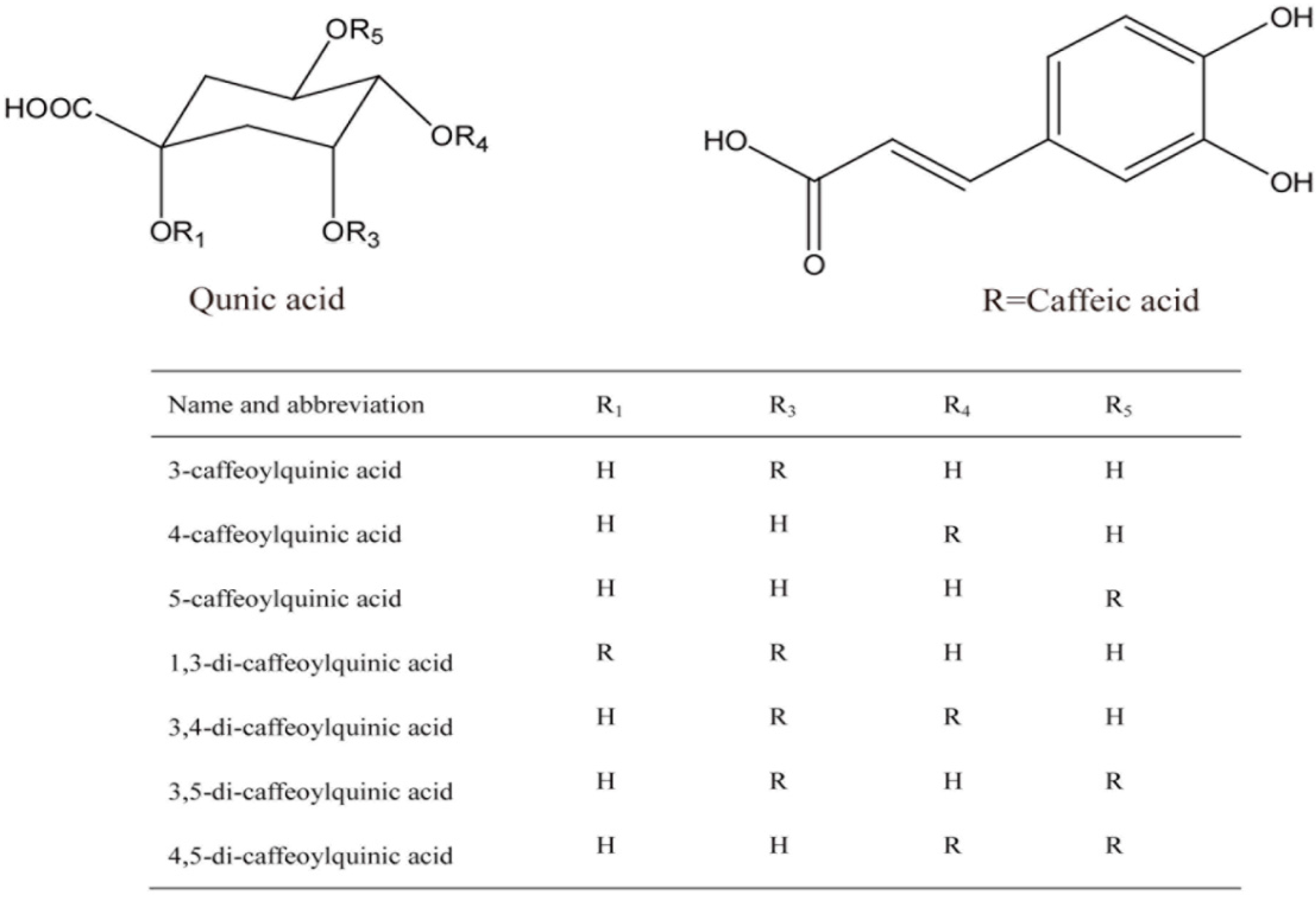
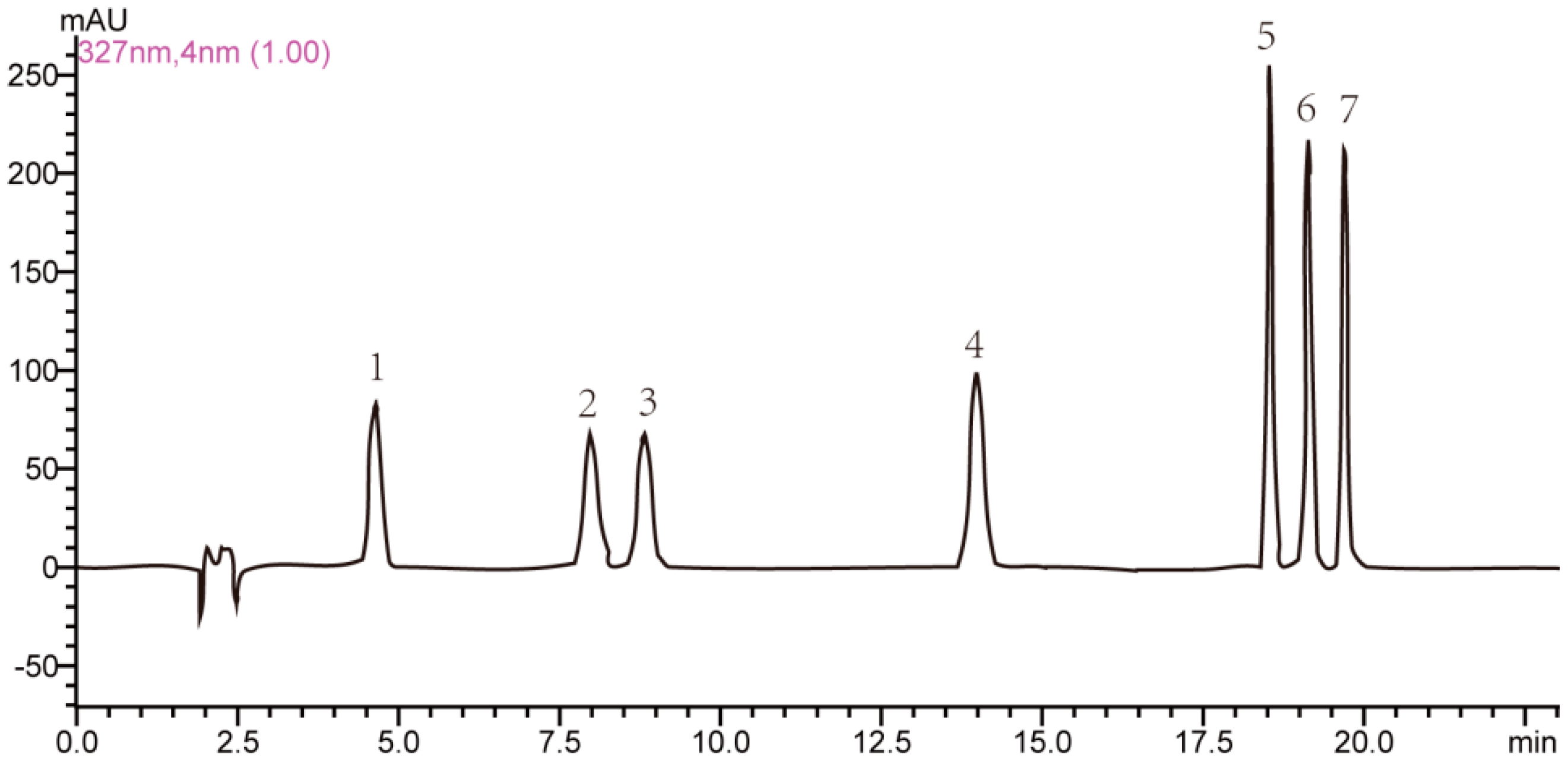

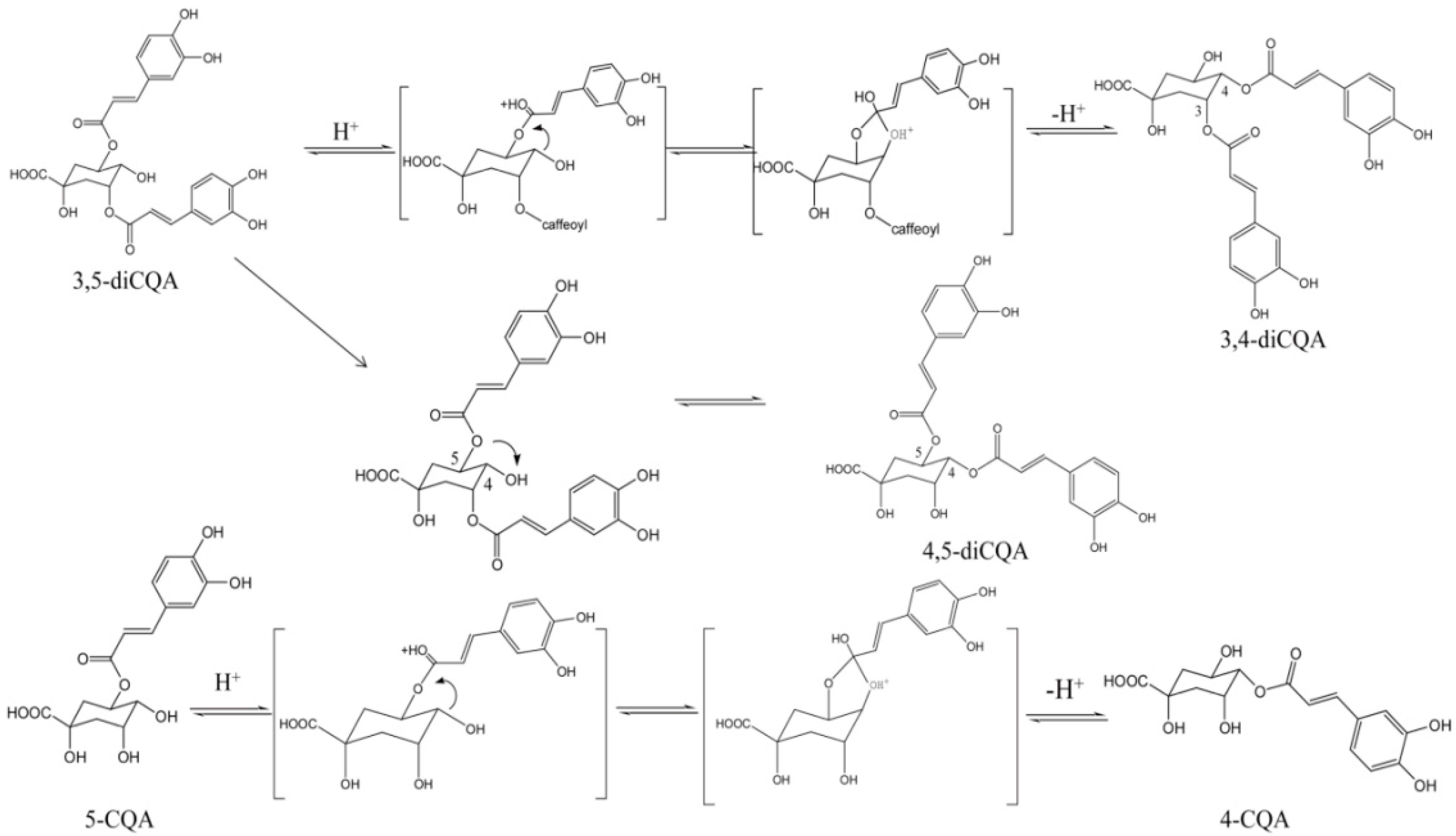



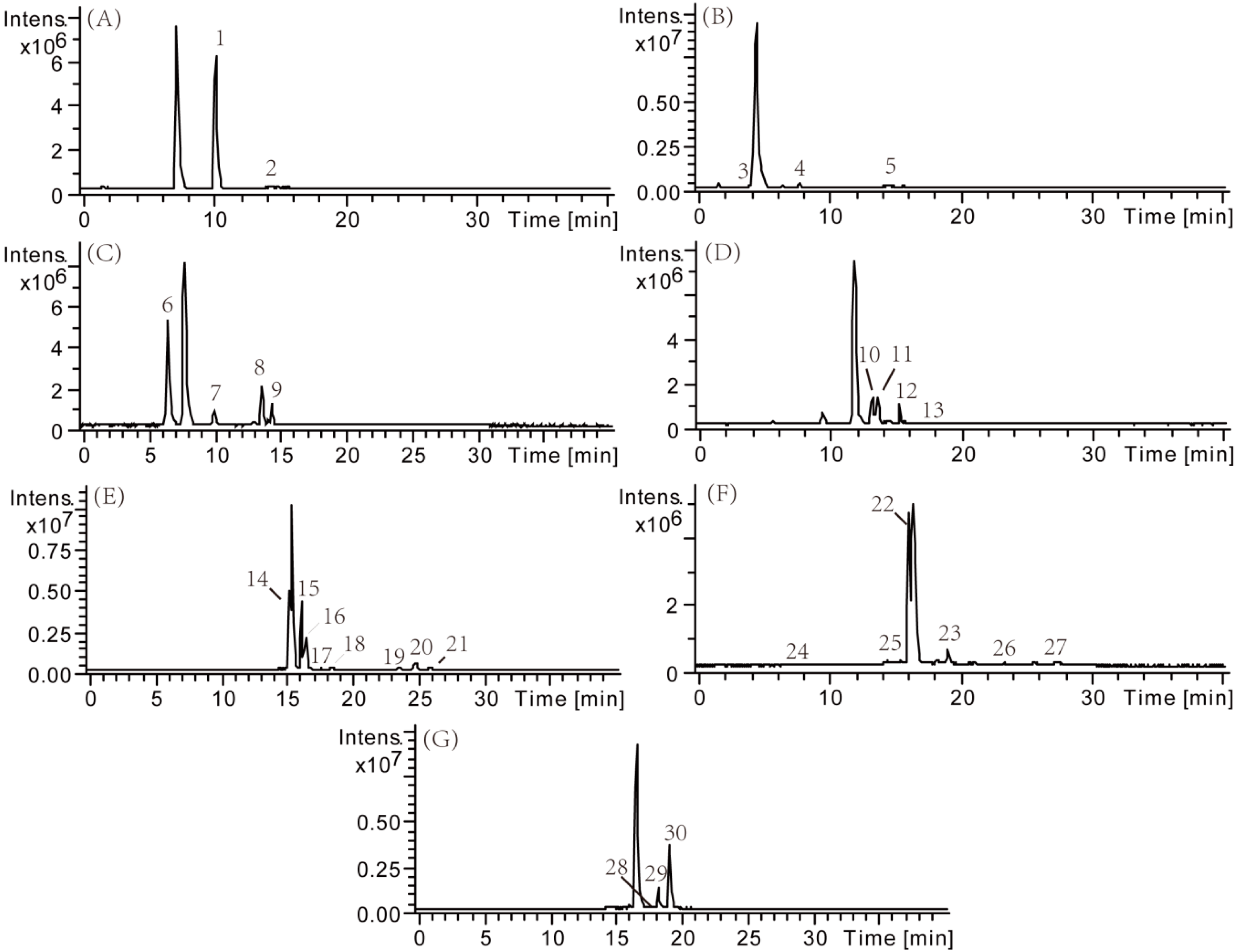

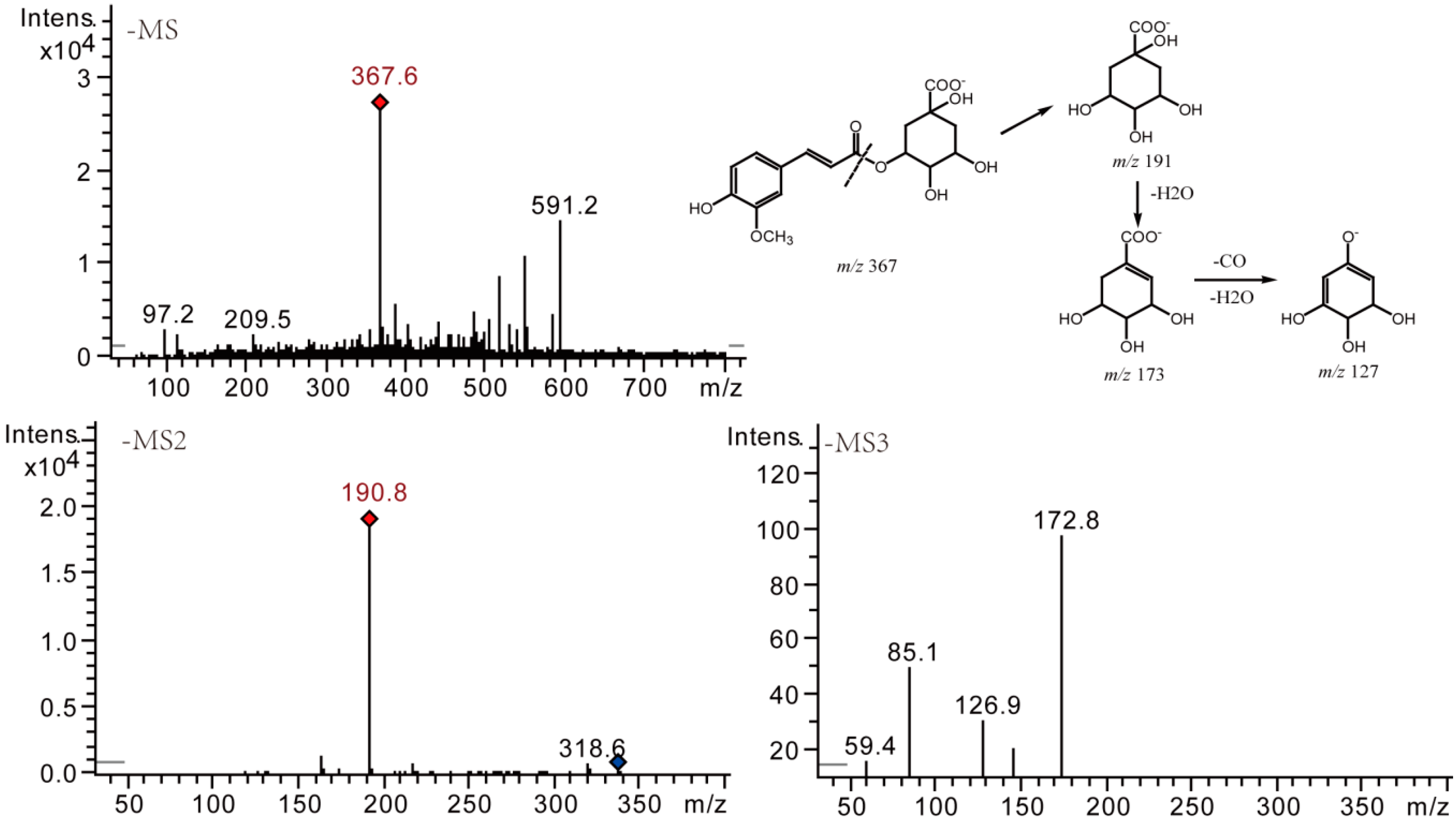

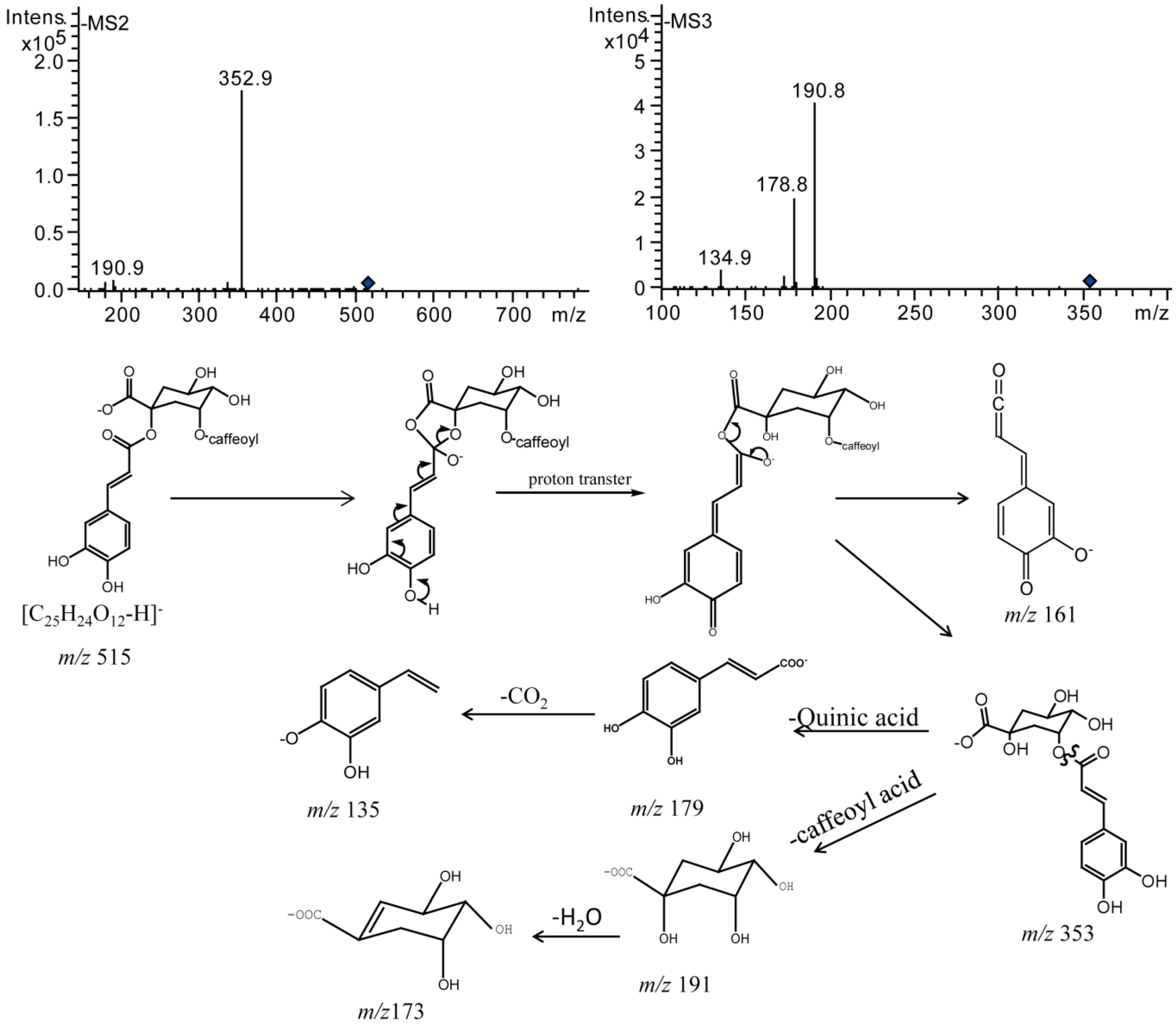
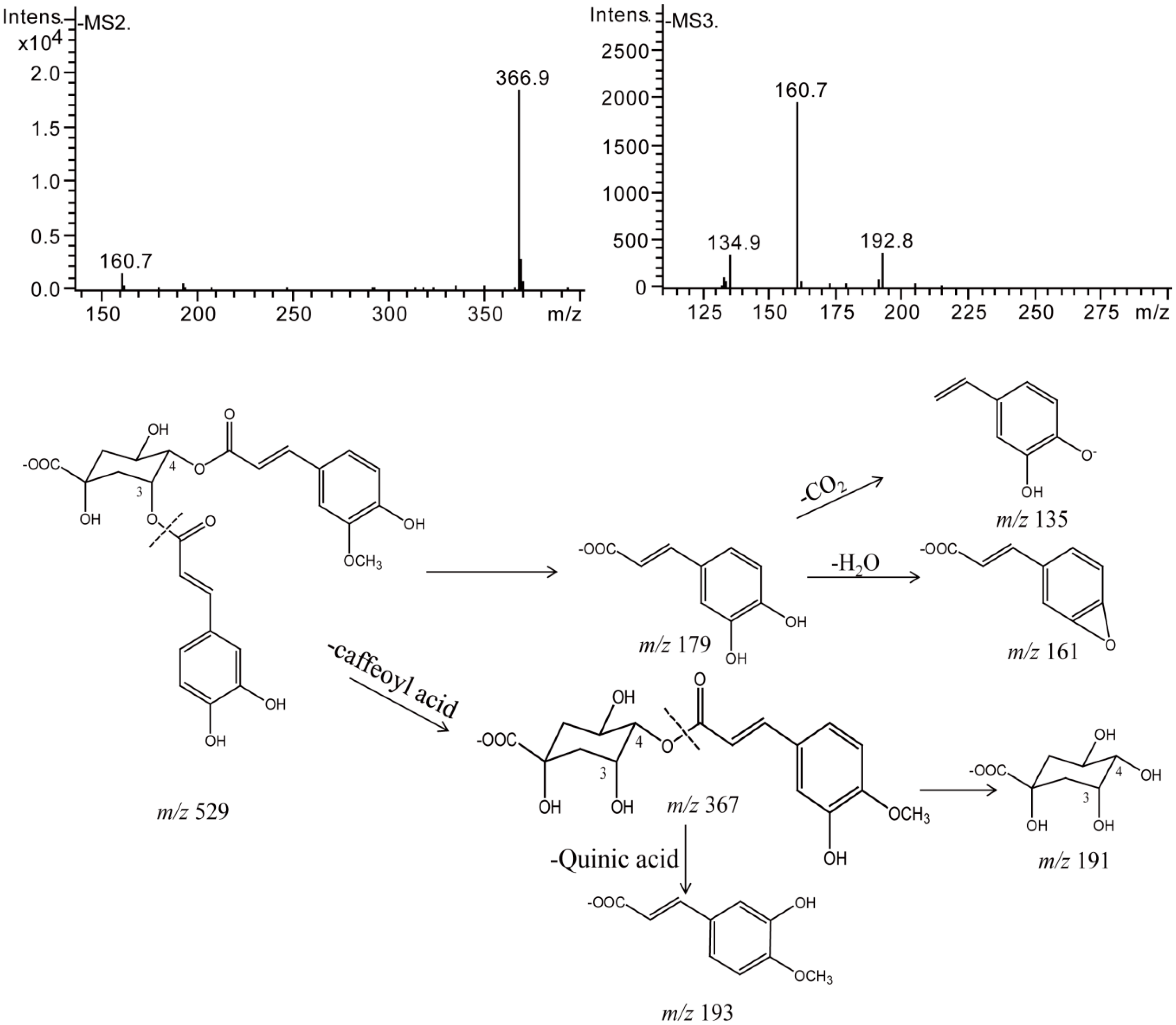
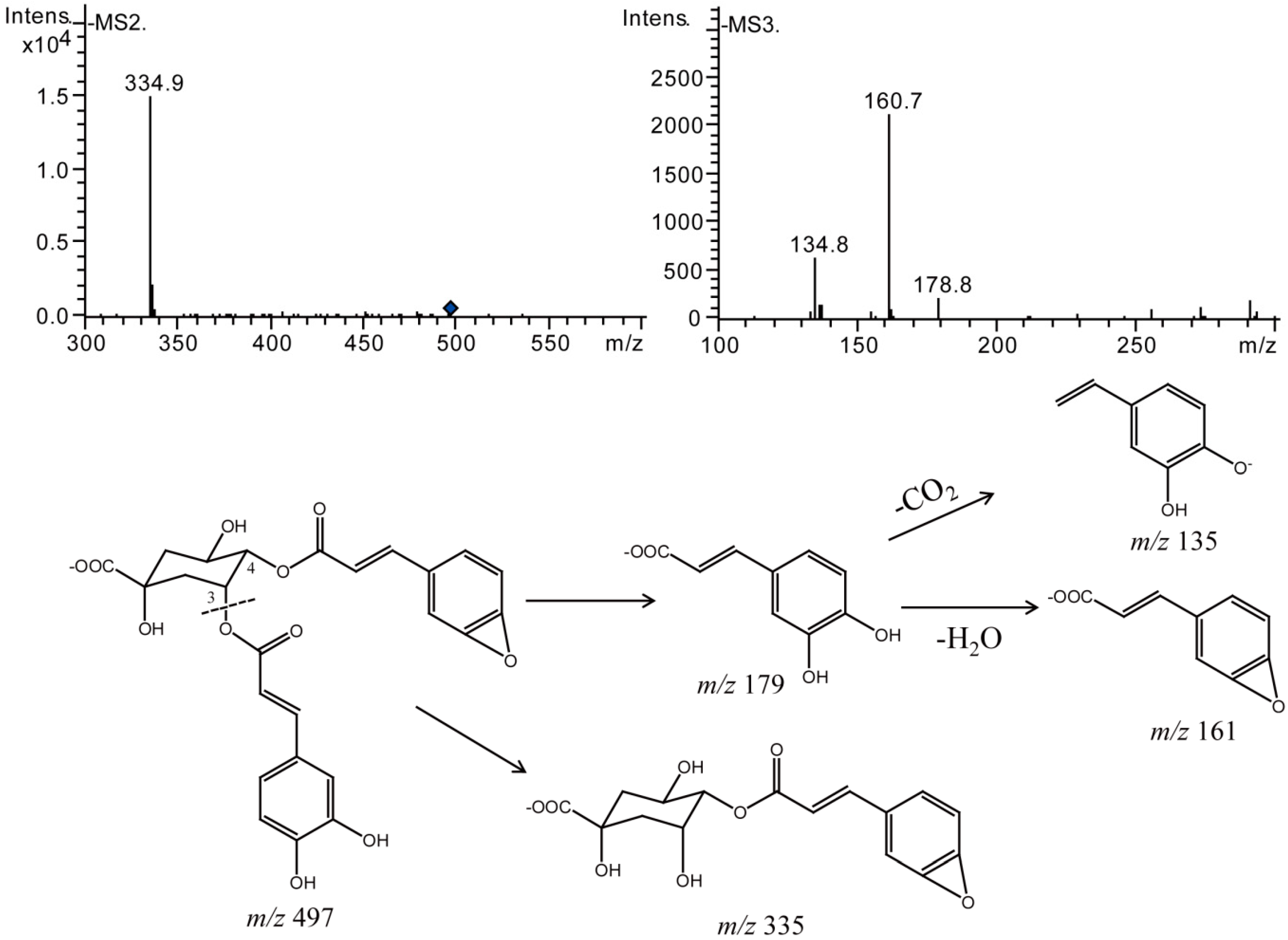
| Compounds | Liner and Range | LOD and LLOQ | |||
|---|---|---|---|---|---|
| Range (μg) | y = ax + b | r2 | LOD a (µg/mL) | LLOQ b (µg/mL) | |
| 5-CQA | 0.102–1.102 | y = 107454x + 34148 | 0.9993 | 0.20 | 0.66 |
| 4-CQA | 0.067–1.340 | y = 157825x + 17890 | 0.9999 | 0.25 | 0.83 |
| 3-CQA | 0.044–0.888 | y = 81939x + 35839 | 0.9999 | 0.40 | 1.32 |
| 1,3-diCQA | 0.254–1.278 | y = 117069x − 1843.9 | 0.9998 | 0.25 | 0.82 |
| 3,5-diCQA | 0.213–1.068 | y = 200743x + 13975 | 0.9996 | 0.12 | 0.39 |
| 3,4-diCQA | 0.117–1.175 | y = 284949x + 6894 | 0.9998 | 0.10 | 0.34 |
| 4,5-diCQA | 0.095–0.950 | y = 138795x − 2935.6 | 0.9998 | 0.17 | 0.55 |
| Compounds | Precision (n = 6) | Repeatability (n = 6) | ||
|---|---|---|---|---|
| Peak Area | RSD (%) | Peak Area | RSD (%) | |
| (Mean ± SD) | (Mean ± SD) | |||
| 5-CQA | 1,136,633 ± 3726.424 | 0.33 | 1,082,853 ± 4128.5 | 0.38 |
| 4-CQA | 1,066,820 ± 6423.833 | 0.60 | 1,525,283 ± 6265.7 | 0.41 |
| 3-CQA | 1,137,426 ± 6394.687 | 0.56 | 80,8061.5 ± 6960.9 | 0.86 |
| 1,3-diCQA | 1,454,276 ± 7509.603 | 0.52 | 1,106,342 ± 4587.3 | 0.41 |
| 3,5-diCQA | 1,743,660 ± 8783.64 | 0.50 | 1,958,000 ± 9040.1 | 0.46 |
| 3,4-diCQA | 1,723,104 ± 8654.263 | 0.50 | 2,705,500 ± 11,548.1 | 0.43 |
| 4,5-diCQA | 1,783,382 ± 8864.299 | 0.49 | 1,327,115 ± 18,610.1 | 1.4 |
| No. | tR (min) | [M − H]− | ESI-MS2 | ESI-MS3 | Identification | Relative Content * |
|---|---|---|---|---|---|---|
| 5-CQA | 7.3 | 353 | 191 | 173, 127, 111, 85 | 5-CQA | 74.13% |
| 1 b | 10.2 | 353 | 191 | 173, 127, 111, 85 | cis-5-CQA | 24% |
| 2 b | 14.4 | 367 | 191 | 173, 127, 85 | Methylated 5-CQA | 1% |
| 3-CQA | 4.6 | 353 | 191 | 173, 127, 85 | 3-CQA | 91.18% |
| 3 b | 4.3 | 353 | 191 | 173, 127, 85 | cis-3-CQA | 3% |
| 4 a | 7.9 | 353 | 173 | 155, 93 | 4-CQA | 3% |
| 5 b | 14.4 | 335 | 161 | 133 | Dehydrated 3-CQA | 2.8% |
| 4-CQA | 7.9 | 353 | 173 | 155, 111, 93 | 4-CQA | 53.91% |
| 6 b | 6.6 | 353 | 173 | 155, 111, 93 | cis-4-CQA | 26% |
| 7 b | 10.1 | 367 | 161 | 133 | Methylated 4-CQA | 5% |
| 8 b | 13.6 | 367 | 161 | 133 | Methylated 4-CQA | 10% |
| 9 b | 14.3 | 335 | 161 | 159 | Dehydrated 4-CQA | 5% |
| 1,3-diCQA | 11.9 | 515 | 353 | 191, 179, 135 | 1,3-diCQA | 86.97% |
| 10 b | 13.3 | 515 | 353 | 191, 179, 135 | A cis-1,3-diCQA | 1% |
| 11 b | 13.6 | 515 | 353 | 191, 179, 135 | A cis-1,3-diCQA | 3% |
| 12 b | 15.3 | 515 | 353 | 191, 179, 135 | Di-cis-1,3-diCQA | 4% |
| 13 a | 16.6 | 515 | 353 | 173, 135 | 4,5-diCQA | 4% |
| 3,4-diCQA | 15.4 | 515 | 353 | 173, 135 | 3,4-diCQA | 67.75% |
| 14 b | 15.2 | 515 | 353 | 173, 135 | cis-3,4-diCQA | 15% |
| 15 b | 16.1 | 515 | 353 | 173, 135 | cis-3,4-diCQA | 12% |
| 16 b | 16.5 | 515 | 353 | 173, 135 | di-cis-3,4-diCQA | 6% |
| 17 b | 17.6 | 529 | 367 | 161, 193, 135 | Methylated 3,4-diCQA | <1% |
| 18 b | 18.4 | 529 | 367 | 161, 193, 135 | Methylated 3,4-diCQA | <1% |
| 19 b | 23.4 | 497 | 335 | 161, 179, 135 | Dehydrated 3,4-diCQA | <1% |
| 20 b | 24.6 | 497 | 335 | 161, 179, 135 | Dehydrated 3,4-diCQA | <1% |
| 21 b | 25.8 | 497 | 335 | 161, 179, 135 | Dehydrated 3,4-di CQA | <1% |
| 3,5-diCQA | 16.4 | 515 | 353 | 191, 135 | 3,5-diCQA | 55.04% |
| 22 b | 16.1 | 515 | 353 | 191, 135 | A cis-1,3-diCQA | 43% |
| 23 b | 19.1 | 515 | 353 | 191, 135 | A cis-1,3-diCQA | 1% |
| 24 a | 7.4 | 353 | 191 | 173 | 5-CQA | <1% |
| 25 a | 15.4 | 515 | 353 | 173, 135 | 3,4-diCQA | <1% |
| 26 b | 21.0 | 529 | 367 | 335, 161, 135 | Methylated 3,5-diCQA | <1% |
| 27 b | 27.3 | 543 | 381 | 161, 179, 135 | Ethylated 3,5-diCQA | <1% |
| 4,5-diCQA | 16.6 | 515 | 353 | 173, 135 | 4,5-diCQA | 80.01% |
| 28 b | 17.8 | 515 | 353 | 173, 135 | A cis-4,5-diCQA | <1% |
| 29 b | 18.2 | 515 | 353 | 173, 135 | A cis-4,5-diCQA | 5% |
| 30 b | 19.0 | 515 | 353 | 173, 135 | di-cis-4,5-diCQA | 12% |
© 2016 by the authors. Licensee MDPI, Basel, Switzerland. This article is an open access article distributed under the terms and conditions of the Creative Commons Attribution (CC-BY) license ( http://creativecommons.org/licenses/by/4.0/).
Share and Cite
Xue, M.; Shi, H.; Zhang, J.; Liu, Q.-Q.; Guan, J.; Zhang, J.-Y.; Ma, Q. Stability and Degradation of Caffeoylquinic Acids under Different Storage Conditions Studied by High-Performance Liquid Chromatography with Photo Diode Array Detection and High-Performance Liquid Chromatography with Electrospray Ionization Collision-Induced Dissociation Tandem Mass Spectrometry. Molecules 2016, 21, 948. https://doi.org/10.3390/molecules21070948
Xue M, Shi H, Zhang J, Liu Q-Q, Guan J, Zhang J-Y, Ma Q. Stability and Degradation of Caffeoylquinic Acids under Different Storage Conditions Studied by High-Performance Liquid Chromatography with Photo Diode Array Detection and High-Performance Liquid Chromatography with Electrospray Ionization Collision-Induced Dissociation Tandem Mass Spectrometry. Molecules. 2016; 21(7):948. https://doi.org/10.3390/molecules21070948
Chicago/Turabian StyleXue, Meng, Hang Shi, Jiao Zhang, Qing-Quan Liu, Jun Guan, Jia-Yu Zhang, and Qun Ma. 2016. "Stability and Degradation of Caffeoylquinic Acids under Different Storage Conditions Studied by High-Performance Liquid Chromatography with Photo Diode Array Detection and High-Performance Liquid Chromatography with Electrospray Ionization Collision-Induced Dissociation Tandem Mass Spectrometry" Molecules 21, no. 7: 948. https://doi.org/10.3390/molecules21070948
APA StyleXue, M., Shi, H., Zhang, J., Liu, Q.-Q., Guan, J., Zhang, J.-Y., & Ma, Q. (2016). Stability and Degradation of Caffeoylquinic Acids under Different Storage Conditions Studied by High-Performance Liquid Chromatography with Photo Diode Array Detection and High-Performance Liquid Chromatography with Electrospray Ionization Collision-Induced Dissociation Tandem Mass Spectrometry. Molecules, 21(7), 948. https://doi.org/10.3390/molecules21070948




